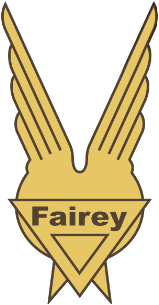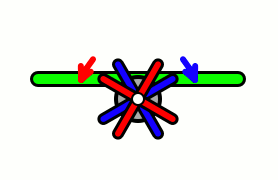Related Research Articles

The Fairey Aviation Company Limited was a British aircraft manufacturer of the first half of the 20th century based in Hayes in Middlesex and Heaton Chapel and RAF Ringway in Cheshire. Notable for the design of a number of important military aircraft, including the Fairey III family, the Swordfish, Firefly, and Gannet, it had a strong presence in the supply of naval aircraft, and also built bombers for the RAF.
Saunders-Roe Limited, also known as Saro, was a British aero- and marine-engineering company based at Columbine Works, East Cowes, Isle of Wight.

Aircraft equipped with contra-rotating propellers, also referred to as CRP, coaxial contra-rotating propellers, or high-speed propellers, apply the maximum power of usually a single piston or turboprop engine to drive a pair of coaxial propellers in contra-rotation. Two propellers are arranged one behind the other, and power is transferred from the engine via a planetary gear or spur gear transmission. Contra-rotating propellers are also known as counter-rotating propellers, although counter-rotating propellers is much more widely used when referring to airscrews on separate non-coaxial shafts turning in opposite directions.

The Supermarine Spiteful was a British Rolls-Royce Griffon-engined fighter aircraft designed by Supermarine to Air Ministry specification F.1/43 during the Second World War as a successor to the Spitfire. It had a new wing design to improve its critical Mach number, and allow safe operations at higher speeds. The new design also had a modern inwards-retracting undercarriage. Other changes included a larger fin to improve the somewhat marginal stability of Griffon Spitfires and changes to the mounting of the engine to tilt it down slightly for better visibility over the nose.

In aeronautics, a variable-pitch propeller is a type of propeller (airscrew) with blades that can be rotated around their long axis to change the blade pitch. A controllable-pitch propeller is one where the pitch is controlled manually by the pilot. Alternatively, a constant-speed propeller is one where the pilot sets the desired engine speed (RPM), and the blade pitch is controlled automatically without the pilot's intervention so that the rotational speed remains constant. The device which controls the propeller pitch and thus speed is called a propeller governor or constant speed unit.
Dowty Propellers is a British engineering company based in Gloucester Business Park, Brockworth, Gloucestershire that specialises in the manufacture, repair and overhaul of propellers and propeller components for customers around the world. It is owned by General Electric, forming part of its GE Aviation Systems division.
Ratier-Figeac is an aircraft components manufacturer in Figeac, France.
Dowty Group was a leading British manufacturer of aircraft equipment. It was listed on the London Stock Exchange and was once a constituent of the FTSE 100 Index. The firm ceased operating as an individual entity following its acquisition by TI Group in 1992.
The Airscrew Company Ltd was a British manufacturing company based in Surrey manufacturing propellers.

Lang Propellers was a British company that manufactured aircraft propellers. The company operated independently from 1913 to 1936.

de Havilland Propellers was established in 1935, as a division of the de Havilland Aircraft company when that company acquired a licence from the Hamilton Standard company of America for the manufacture of variable-pitch propellers at a cost of about £20,000. Licence negotiations were completed in June 1934.
Norman Adrian de Bruyne FRS was born in Punta Arenas Chile on 8 November 1904, and baptised on 19 March 1905 at the Anglican St. James Church, by the Rev. Edwin Aspinall. His father was Dutch and his mother English. He grew up in England, studied science at the University of Cambridge and became a physics researcher. Around 1930, he became interested in aviation. de Bruyne was the first student of the new flying school which Arthur Marshall established in Cambridge in 1931
Heston Aircraft Company was a British aircraft manufacturer based at Heston Aerodrome, Middlesex, England.

The Hordern-Richmond Autoplane was a 1930s British twin engined two seat cabin touring monoplane designed by Edmund Hordern, and constructed by Heston Aircraft Company Ltd.

British shadow factories were the outcome of the Shadow Scheme, a plan devised in 1935 and developed by the British Government in the buildup to World War II to try to meet the urgent need for more aircraft using technology transfer from the motor industry to implement additional manufacturing capacity.
The Metal Airscrew Company was formed in 1919 by Dr. Henry Charles Watts and Henry Leitner to produce hollow metal aircraft propellers with a method set out their joint patent. By 1928 the company name had changed to Metal Propellers Ltd. It remained active until at least 1930.
The Falcon Airscrew Company was a British manufacturer of wooden aircraft propellers, formed during the first World War. In 1923 they claimed 90% of the United Kingdom's propeller production but had closed by the end of the decade.
W. D. Oddy & Company Ltd was a British manufacturer of wooden aircraft propellers, formed in 1919. The company was the main supplier of propellers to Blackburn Aircraft in the first half of the 1920s.

Windsor Propeller is an American manufacturer of propellers and accessories for hobby model aircraft and unmanned aerial vehicles (UAVs). Founded in 1978 in Windsor, Northern California by Fred Jamieson, the company is developing and manufacturing its products under the brand name Master Airscrew. The company is now headquartered in Rancho Cordova, California, selling its products worldwide.
References
- ↑ Permali Gloucester Limited Home Page Archived 9 May 2008 at the Wayback Machine . Permali.co.uk. Retrieved 18 August 2011.
- ↑ http://www.flightglobal.com/pdfarchive/view/1947/1947%20-%201903.html [ dead link ]
- ↑ airscrew blades | li hydulignum | hydulignum two-way | 1942 | 2476 | Flight Archive. Flight International (26 November 1942). Retrieved 18 August 2011.
- ↑ Flight, 10 September 1954
- ↑ Archived 15 September 2008 at the Wayback Machine
- ↑ Archived 15 September 2008 at the Wayback Machine
- ↑ Flight, 9 November 1956